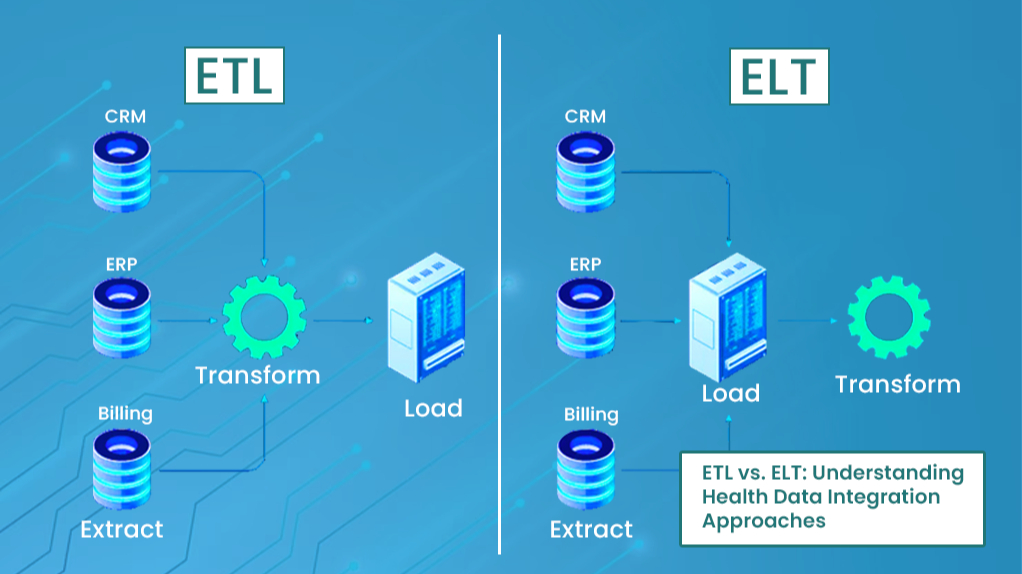Health data integration is a fundamental step in modern healthcare arrangements, allowing providers to gather, process, and analyze data from various sources. Health data is a critical component of advancing healthcare systems. It includes patient records, medical history, treatment plans, diagnostic images, and a vast array of information generated by healthcare providers, researchers, and medical devices. Managing and analyzing health data efficiently and securely is essential for improving patient care, research, and healthcare operations. When it comes to integrating health data, two primary approaches—ETL (Extract, Transform, Load) and ELT (Extract, Load, Transform)—are commonly considered. Let's delve into the differences and considerations for each approach in the context of health data.
ETL (Extract, Transform, Load)
Extraction: In ETL, the first step is to extract data from various sources within the healthcare ecosystem. These sources can include electronic health record (EHR) systems, laboratory information systems (LIS), radiology systems, claims databases, and more. Health data often originates in structured formats like relational databases.
Transformation: Once extracted, health data undergoes transformation. This transformation phase is particularly critical in healthcare due to the need for data standardization, normalization, and cleansing. Transformations can involve mapping different code sets (e.g., SNOMED CT to ICD-10), ensuring data privacy compliance (e.g., HIPAA), and aggregating data for analysis.
Loading: After transformation, the processed health data is loaded into a data warehouse or data repository. Data loading can be batch-oriented or near real-time, depending on the organization's requirements. The loaded data becomes available for reporting, analytics, and research.
Advantages of ETL for Health Data:
Data Quality Assurance: ETL allows thorough data validation, cleansing, and transformation to ensure high data quality, which is paramount in healthcare settings.
Security and Compliance: ETL enables organizations to implement stringent data privacy and security measures during the transformation process.
Structured Analytics: ETL is suitable when health data needs to be transformed into structured formats for traditional analytics.
When to Use ETL for Health Data:
For healthcare organizations with diverse data sources that require complex transformations.
In scenarios where data privacy and compliance are top priorities.
When the target system (e.g., data warehouse) has a different schema from the source systems.
ELT (Extract, Load, Transform)
Extraction: ELT begins with data extraction from health data sources, similar to ETL. However, in ELT, data is extracted without significant transformation.
Loading: Extracted health data is loaded directly into the target data repository, which could be a data warehouse or a big data platform. This approach leverages the processing power and scalability of the target system.
Transformation: Transformation in ELT occurs after data is loaded into the target repository. Data analysts and researchers can perform transformations using SQL queries, data modeling, and other tools within the data repository environment.
Advantages of ELT for Health Data:
Scalability: ELT is well-suited for handling large volumes of raw health data, leveraging the capabilities of modern data platforms.
Data Flexibility: ELT preserves the original data structure, allowing data scientists and analysts to explore and analyze data in its native format.
Cost-Efficiency: ELT often eliminates the need for an intermediate staging area, reducing storage costs.
When to Use ELT for Health Data:
In healthcare organizations with modern data warehousing or big data infrastructure capable of handling raw data transformations.
When the need for quick access to raw health data for research or analytics outweighs extensive upfront transformations.
In scenarios where data volumes are substantial and can benefit from parallel processing.
The choice between ETL and ELT for health data integration depends on the specific needs, infrastructure, and regulatory constraints of healthcare organizations. Both approaches have their merits and are valuable tools for managing and leveraging health data effectively. Ultimately, healthcare decision-makers should assess their unique circumstances to determine the most suitable approach to ensure data quality, security, and accessibility in the ever-evolving landscape of health data management and analysis.
In practice, healthcare organizations often adopt hybrid approaches, combining elements of both ETL and ELT to address diverse data integration needs. For example, they may use ETL for complex data transformations involving patient record standardization and ELT for continuous streaming of data from medical devices.

